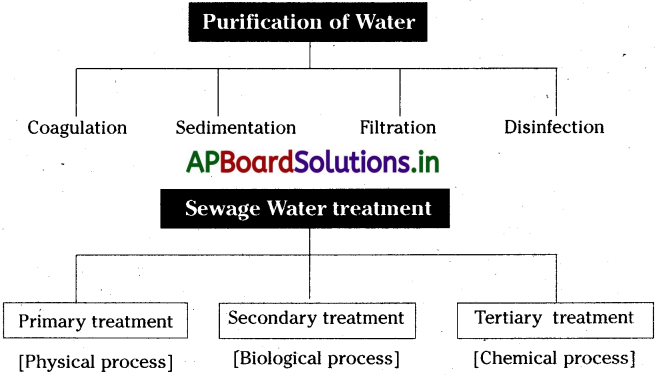Students can go through AP Board 7th Class Science Notes 12th Lesson Soil and Water to understand and remember the concept easily.
AP Board 7th Class Science Notes 11th Lesson Soil and Water
→ The upper most layer of earth’s crust is known as ‘Soil’.
→ The scientific study of soil is called ‘Pedology’.
→ Soil is a habitat for many living organisms.
→ Soil is a mixture of rock particles and humus.
→ Soil is formed by the process of ‘weathering’.
→ The process of formation of soil from the parent rock by the process of weathering is called ‘Pedogenesis’.
![]()
→ Soil profile is nothing but a vertical section through different horizontal layers of soil.
→ Soil can be classified mainly as sandy, clayey and loamy.
→ Layers of the soil called ’Horizons’.
→ The absorption and downward movement of water through the soil layers is called ‘Percolation’.
→ Amount of water that passes through gives us percolation rate. It is highest in the sandy soil and least in the clayey soil.
→ Soil testing guides the farmers to improve their crop production.
→ Loss of the upper fertile layer of soil is known as soil erosion. Plants help to prevent soil erosion.
→ Water is very essential for all living beings without water there can be no life on this planet.
→ The rainwater moves down through the soil and fills the spaces and cracks deep below the ground as Ground water.
→ This process of entry of water into the ground is called Infiltration.
→ The upper Jevel at which water stands in the ground is called water table.
→ The ground water stored between layers of hard rock below the water table is called Aquifer.
→ Only 1% of all water sources is available as usable fresh water.
→ All the waste water released by home, industries, hospitals, offices and other users are collectively called sewage.
→ Waste water should be treated in waste water treatment plant before disposal. Sewage treatment involves physical, biological and chemical process done at three stages.
![]()
→ Water must be conserved by individual efforts as well as through efforts made by community.
→ Septic tanks also help in waste water disposal.
→ Soil profile : Section through different layers of the soil.
→ Sandy : Very fine loose fragment of crushed rock.
→ Clayey : A type of soil that can be easy to roll into a ball or ring and not cracked.
→ Loamy : A medium texture soil containing a mixture of large and small mineral particles (rich soil)
→ Percolation : Water passing down through the soil particles is called percolation.
→ Moisture content : The ratio of the mass of water held in the soil to the dry soil is called moisture content of the soil.
→ Soil erosion : Removal of top soil by wind, water or any other means.
→ Crop rotation : Changing crops after a period of time to increase the soil fertility.
→ Soil conservation : Preventing the degradation of soil from soil erosion.
→ Sewage : Liquid waste drained from houses etc. for disposal.
→ Contaminants : Pollutants present in the water.
→ Activated Sludge : Cleaned sludge.
→ Check dams : A type of dam constructed to conserve water to revive the forest area.
![]()
→ Aerobic bacteria : Bacteria that utilize oxygen for growth and oxygen based metabolism. They help in the decomposition of excess carbon.
→ Bar screens : These are used to remove rags, sticks, cans, plastic packets etc. from waste water.
→ Ground water : The rain water moves down through the soil and fills the spaces and cracks deep below the ground. This is called as ground water.
→ Water table : The upper level at which water stands in the ground is called water table.
→ Aquifer : Ground water is stored between layers of hard rock below the water table is called as aquifer.

